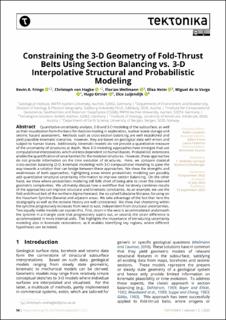Constraining the 3-D Geometry of Fold-Thrust Belts Using Section Balancing vs. 3-D Interpolative Structural and Probabilistic Modeling
Frings, Kevin; von Hagke, Christoph; Wellmann, Florian; Heim, Elisa; de la Varga, Miguel; Ortner, Hugo; Luijendijk, Elco
Journal article
Published version

Åpne
Permanent lenke
https://hdl.handle.net/11250/3124108Utgivelsesdato
2023Metadata
Vis full innførselSamlinger
- Department of Earth Science [1050]
- Registrations from Cristin [9791]
Sammendrag
Quantitative uncertainty analysis, 2-D and 3-D modeling of the subsurface, as well as their visualization form the basis for decision making in exploration, nuclear waste storage and seismic hazard assessment. Methods such as cross-section balancing are well established and yield plausible kinematic scenarios. However, they are based on geological data with errors and subject to human biases. Additionally, kinematic models do not provide a quantitative measure of the uncertainty of structures at depth. New 3-D modeling approaches have emerged that use computational interpolation, which are less dependent on human biases. Probabilistic extensions enable the quantification of uncertainties for the modeled structures. However, these approaches do not provide information on the time evolution of structures. Here, we compare classical cross-section balancing (2-D, kinematic modeling) with 3-D computational modeling to pave the way towards a solution that can bridge between these approaches. We show the strengths and weaknesses of both approaches, highlighting areas where probabilistic modeling can possibly add quantitative structural uncertainty information to improve section balancing. On the other hand, we show where probabilistic modeling still falls short of being able to cover the observed geometric complexities. We ultimately discuss how a workflow that iteratively combines results of the approaches can improve structural and kinematic constraints. As an example, we use the fold-and-thrust belt of the northern Alpine Foreland, the so-called Subalpine Molasse, focusing on the Hausham Syncline (Bavaria) and adjacent areas. We take advantage of the fact that here the stratigraphy as well as the tectonic history are well constrained. We show that shortening within the syncline progressively increases from west to east, independent from structural uncertainties. Two equally viable models can explain this. First, strain in the west is accommodated underneath the syncline in a triangle zone that progressively tapers out, or second, the strain difference is accommodated in more internal units. This highlights the importance of introducing uncertainty modeling also in kinematic restorations, as it enables identifying key regions, where different hypotheses can be tested.
